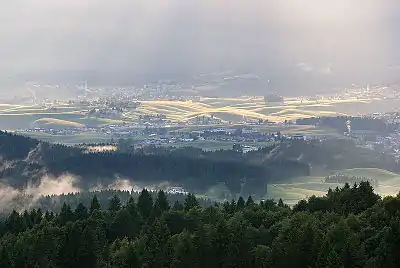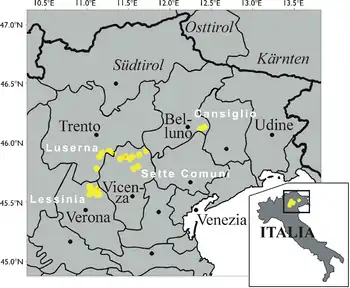Sette Comuni
The Sette Comuni, or Altopiano dei Sette Comuni (Cimbrian: Siben Komoin, German: Sieben Gemeinden), are seven comuni that formed a Cimbrian enclave in the Veneto region of north-east Italy. The place is also known as the Asiago Plateau, and it was the site of many battles during World War I. The most important comune is the city of Asiago, which gave its name to the cheese of the same name. Cimbrian, a dialect of Upper German, was the native tongue, and the area was ethnically and culturally distinct from the surrounding comuni.[1] The Sette Comuni are located in mountainous territory, ranging from 500 to 2300 metres above sea level.

Comuni

| Comune | Cimbrian | German | Inhabitants | Altitude (m) | Notes |
| Asiago | Sléghe/Schlège | Schlägen | 6533 | 1001 | |
| Enego | Ghenébe/Jenève | Jeneve | 1927 | 800 | |
| Foza | Vüsche/Vütsche | Fütze | 731 | 1083 | |
| Gallio | Gell(e)/Ghèl | Gelle | 2331 | 1093 | |
| Lusiana | Lusaan | Lusian | 2833 | 752 | |
| Roana | Robàan | Rovan or Rain | 4245 | 994 | |
| Rotzo | Rotz | Ross | 620 | 938 | |
| Conco | Kunken | 2252 | 830 | the "eighth comune", a frazione of Lusiana until 1796 |
History

The seven comuni formed into a loose commonwealth in 1310. They were historically under the suzerainty of the Milanese House of Visconti and then under the Republic of Venice. Under both they enjoyed wide cultural and political autonomy in exchange for their loyalty. This autonomous status came to an end with the Napoleonic Wars and the demise of the Serenìsima in 1807.
World War I
.jpg.webp)
.jpg.webp)
During the First World War the territory was located along the border between the Kingdom of Italy and the Austro-Hungarian Empire. Many battles took place here between 1915 and 1918. Almost all the towns were completely destroyed by the war.
Cimbrian

Cimbrian has gone extinct in most of the comuni. Only in Robàan and its district of Mittebald/Toballe (Mittewald, Mezzaselva) has Cimbrian survived.
Robàan is home to the Agustin Prunner Cultural Institute, which is a repository of the Cimbrian culture and cooperates with other linguistic enclaves in Lusern, Fersental, Sappada, Sauris, the Thirteen Communities and Timau. Vestiges of the language are found in family and place names, which are mostly still Cimbrian.
See also
References
- l'Altopiano di Asiago e la Spettabile Reggenza dei Sette Comuni (in Italian). magicoveneto.it. Accessed September 2013.